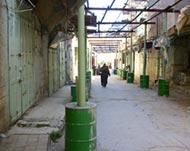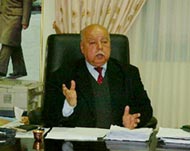Scars of massacre still fresh in Hebron
It happened shortly after dawn on 25 February 1994, when an American Jewish immigrant named Baruch Goldstein left his home at the settlement of Kiryat Araba (just outside Hebron), carrying his army-issued Galilion sub-machine gun.

The middle-aged bearded physician settler, dressed in combat camouflage, headed for the Ibrahimi Mosque – known to Jews as the Tomb of the Patriarchs – in the heart of the town’s old quarter where hundreds of Arab worshippers were finishing their morning prayer.
And as soon as the faithful knelt down, Goldstein began spraying them with bullets from his automatic weapon. Within three minutes, 29 worshippers were dead and twice as many were either injured or maimed.
Eventually, survivors overpowered the settler, who was still shooting, and killed him. The Israeli government, then headed by Yitzhak Rabin, sought to avoid responsibility for the massacre, saying it was “thunder on clear day.”
While other Talmudic settlers embraced Goldstein as a hero and great saint, the Israeli army imposed a hermetic curfew on the estimated 170,000 Palestinian inhabitants of Hebron, which lasted for nearly two months.
The settlers were allowed to patrol Hebron’s streets, brandishing their Uzis and M-16s.
No improvement
No arrests or prosecutions were made in the killing of 29 Palestinian worshippers.
An Israeli inquiry panel (the Shamgar Commission) issued a decree allocating over 65% of the Ibrahimi Mosque’s interior space to the settlers, leaving the remaining 35% for Muslims.
 |
|
Israeli policies have made life |
Eleven years on, the situation in Hebron shows no sign of improvement.
The estimated 550-600 settlers, including some 200 Yeshiva students studying the Talmud at the hands of hardline rabbis such as Dov Lior, still harass Palestinians on a daily basis, often in full view of the Israeli army.
The settlers, who have erected a memorial plaque in Kiryat Arba in Goldstein’s honour, are mostly affiliated with the Kach and Kahana Hay movements, both of which are classified as terrorist groups by the US and Israel itself.
This none-too-subtle Israeli policy of making life unbearable for Palestinians in the old town has resulted in an exodus of Palestinians from the city.
Victims punished
According to Hebron Mayor Mustafa Abdul Nabi Natshi, the Israeli state and its army punished the victims instead of punishing the criminals.
 |
|
Empty roads testify to exodus of |
“They confiscated the bulk of the Ibrahimi Mosque and gave it to the settlers on a silver platter. They forced thousands of Palestinians to close down their homes and businesses.
“In short, Israel has been effecting a silent but real ethnic cleansing in our city by expelling tens of thousands of people from their homes, all in order to ensure comfort for these racist thugs,” Natshi told Aljazeera.net.
He said the occupation army continued to maintain a heavy presence all over Hebron, especially in the old town.
“Today, our people are effectively barred from travelling or even walking on many streets in and around the old town. Can you imagine any other city in this world where locals are barred from walking on the streets of their own town?”
Concept stretched
According to the Hebron Protocol, signed between the Palestinian Authority (PA) and the Israeli government in 1996, Hebron was divided into two parts: H-1, to be run by the PA, and H-2 (the old town and contiguous neighbourhoods), where the Israeli army was to maintain “security responsibility”.
 |
|
Mayor Mustafa Natshi says the |
However, Israeli generals managed to stretch the concept of “security responsibility” to imply absolute sovereignty, including hounding and systematically persecuting the estimated erstwhile 30,000 Palestinians of the old town.
Today, all but a few thousand Palestinians in the old town have been forced to flee to the nominally PA-run parts of Hebron.
Indeed, months of uninterrupted hermetic curfews, coupled with daily harassment by heavily armed Jewish settlers, left no choice for many Palestinians who could afford to rent or buy a home outside the old town.
Hamid Jabari is one of the Palestinians forced to “temporarily” relocate, thanks to Jewish harassment.
He told Aljazeera.net that Israeli troops and Jewish settlers employed “every imaginable diabolical tactic to make our life unbearable”.
Access prevented
Jabari continued: “They did everything you can imagine, from splashing human urine on our kids while on their way to school to barring our family members from returning home under the pretext that the area was a closed military zone.
“Can you imagine soldiers stationed outside your own home for the sole purpose of preventing you from accessing it? This was happening here.”
Most of Hebron’s streets are closed to Palestinian traffic with huge concrete slabs.
Israeli authorities cite security fears to justify draconian measures, which are forcing Palestinians to take a circuitous route involving 10 additional kilometres to reach the next street or neighbourhood.